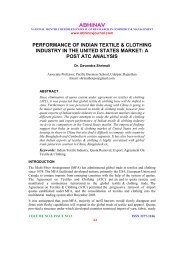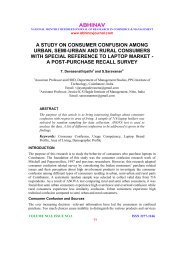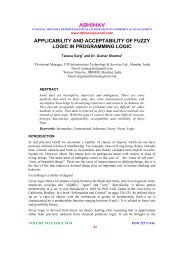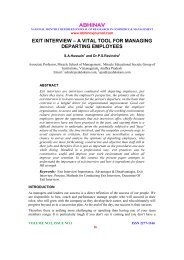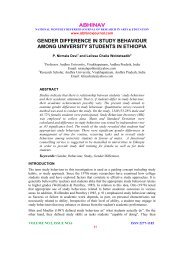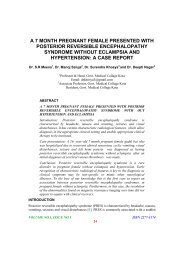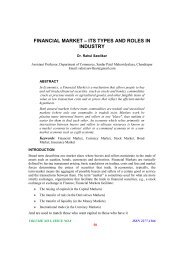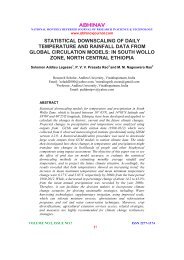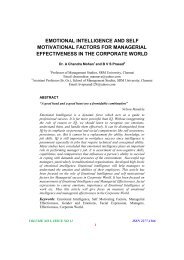Software Development Life Cycle (SDLC) - Abhinav Institute of ...
Software Development Life Cycle (SDLC) - Abhinav Institute of ...
Software Development Life Cycle (SDLC) - Abhinav Institute of ...
Create successful ePaper yourself
Turn your PDF publications into a flip-book with our unique Google optimized e-Paper software.
ABHINAV<br />
NATIONAL MONTHLY REFEREED JOURNAL OF RESEARCH IN SCIENCE & TECHNOLOGY<br />
www.abhinavjournal.com<br />
SOFTWARE DEVELOPMENT LIFE CYCLE (<strong>SDLC</strong>)<br />
ANALYTICAL COMPARISON AND SURVEY ON<br />
TRADITIONAL AND AGILE METHODOLOGY<br />
Sujit Kumar Dora 1 and Pushkar Dubey 2<br />
1 Programmer, Computer Science & Engineering, Padmashree Krutartha Acharya College <strong>of</strong><br />
Engineering (PKACE), Bargarh, Odisha, India<br />
Email : sujit_dora@rediffmail.com<br />
2 Lecturer, Management, Padmashree Krutartha Acharya College <strong>of</strong> Engineering (PKACE),<br />
Bargarh, Odisha, India<br />
Email : pushkardubey@rediffmail.com<br />
ABSTRACT<br />
This research concerned with the s<strong>of</strong>tware management processes that<br />
examine the area <strong>of</strong> s<strong>of</strong>tware development through the development models,<br />
which are known as s<strong>of</strong>tware development life cycle. <strong>S<strong>of</strong>tware</strong> <strong>Development</strong><br />
<strong>Life</strong> <strong>Cycle</strong> (<strong>SDLC</strong>) methodologies are mechanisms to assure that s<strong>of</strong>tware<br />
meet established requirements. These methodologies impose various degrees<br />
<strong>of</strong> discipline to the s<strong>of</strong>tware development process with the goal <strong>of</strong> making<br />
the process more efficient and predictable. This paper review & explain the<br />
heavyweight methodologies (Traditional <strong>SDLC</strong>) & Lightweight methodology<br />
(agile <strong>SDLC</strong>) and also draws a predictable comparison between both<br />
methodologies.<br />
Keywords: <strong>S<strong>of</strong>tware</strong> development life cycle (<strong>SDLC</strong>), traditional method,<br />
agile method.<br />
INTRODUCTION<br />
The process <strong>of</strong> building computer s<strong>of</strong>tware and information systems has been always<br />
dictated by different development methodologies. A s<strong>of</strong>tware development methodology<br />
refers to the framework that is used to plan, manage, and control the process <strong>of</strong> developing<br />
an information system. Formally, a s<strong>of</strong>tware development methodology is known as <strong>SDLC</strong><br />
short for <strong>S<strong>of</strong>tware</strong> <strong>Development</strong> <strong>Life</strong> <strong>Cycle</strong>. This methodology or process is divided into<br />
some phases such as Requirement Analysis, Design, Coding, Testing, Installation and<br />
Maintenance.<br />
REQUIREMENT ANALYSIS<br />
Requirement analysis is the first phase <strong>of</strong> the <strong>S<strong>of</strong>tware</strong> <strong>Development</strong> <strong>Life</strong> <strong>Cycle</strong>. The main<br />
aim <strong>of</strong> this phase is to know the actual requirement <strong>of</strong> client’s and to document them<br />
properly. The emphasis in requirement analysis is on identifying what is needed from the<br />
system. It is one <strong>of</strong> the most essential phases in <strong>S<strong>of</strong>tware</strong> <strong>Development</strong> <strong>Life</strong> <strong>Cycle</strong>. The<br />
VOLUME NO.2, ISSUE NO.8 ISSN 2277-1174<br />
22
ABHINAV<br />
NATIONAL MONTHLY REFEREED JOURNAL OF RESEARCH IN SCIENCE & TECHNOLOGY<br />
www.abhinavjournal.com<br />
output <strong>of</strong> requirement analysis is <strong>S<strong>of</strong>tware</strong> Requirement Specification (SRS); it is a complete<br />
and comprehensive description <strong>of</strong> the behavior <strong>of</strong> the s<strong>of</strong>tware to be developed.<br />
Design<br />
It is the most creative phase in <strong>S<strong>of</strong>tware</strong> <strong>Development</strong> <strong>Life</strong> <strong>Cycle</strong>. The goal <strong>of</strong> this phase is<br />
to transform the requirement specification into a structure or plan. It is the process <strong>of</strong><br />
planning and problem solving for a s<strong>of</strong>tware solution. It implicates s<strong>of</strong>tware developers and<br />
designers to define the plan for a solution. The output <strong>of</strong> this phase is <strong>S<strong>of</strong>tware</strong> Design<br />
Document (SDD).<br />
Coding<br />
In this phase <strong>S<strong>of</strong>tware</strong> Design Document (SDD) is converted into code by using some<br />
programming language. It is the logical phase <strong>of</strong> the <strong>S<strong>of</strong>tware</strong> <strong>Development</strong> <strong>Life</strong> <strong>Cycle</strong>. The<br />
output <strong>of</strong> this phase is program code.<br />
Testing<br />
Just after coding phase, testing is carried out to know the outcome <strong>of</strong> application. Testing is<br />
made to know the actual result and the expected result. This is most important and powerful<br />
phase. Effective testing will provide high quality s<strong>of</strong>tware products, lower maintenance<br />
costs, and more accurate and reliable results.<br />
Maintenance<br />
This is the final stage <strong>of</strong> <strong>SDLC</strong>, where the s<strong>of</strong>tware that is being developed distributed to end<br />
users who are responsible for maintaining and using it for proper operations.<br />
<strong>SDLC</strong> Models<br />
There is various s<strong>of</strong>tware development approaches defined and designed which are used<br />
during development process <strong>of</strong> s<strong>of</strong>tware, these approaches are also referred as "<strong>S<strong>of</strong>tware</strong><br />
<strong>Development</strong> Process Models". Each process model follows a particular life cycle in order to<br />
ensure success in process <strong>of</strong> s<strong>of</strong>tware development. Some <strong>of</strong> the <strong>SDLC</strong> Models are:<br />
<br />
<br />
<br />
<br />
<br />
<br />
<br />
Waterfall Model<br />
Spiral Model<br />
Iterative Model<br />
Incremental Model<br />
Prototyping Model<br />
V -Shaped Model<br />
RAD Model<br />
Waterfall Model<br />
The Waterfall model is the classical model <strong>of</strong> s<strong>of</strong>tware engineering [1] also it is referred as a<br />
linear-sequential life cycle model. It defines some basic tasks, which are carried out in<br />
sequence: requirements definition, Architecture design, detailed design, implementation,<br />
VOLUME NO.2, ISSUE NO.8 ISSN 2277-1174<br />
23
ABHINAV<br />
NATIONAL MONTHLY REFEREED JOURNAL OF RESEARCH IN SCIENCE & TECHNOLOGY<br />
www.abhinavjournal.com<br />
component verification, integration verification and requirements validation. In a waterfall<br />
model, each phase must be completed in its entirety before the next phase can begin. At the<br />
end <strong>of</strong> each phase, a review takes place to determine if the project is on the right path and<br />
whether or not to continue or discard the project. The waterfall model serves as a baseline for<br />
many other lifecycle models . [1][2]<br />
Spiral Model<br />
The spiral model is similar to the incremental model, with more emphasis placed on risk<br />
analysis. The spiral model has four phases: Planning, Risk Analysis, Engineering and<br />
Evaluation. A s<strong>of</strong>tware project repeatedly passes through these phases in iterations (called<br />
Spirals in this model). The baseline spiral, starting in the planning phase, requirement is<br />
gathered and risk is assessed. Each subsequent spiral builds on the baseline spiral.<br />
Requirements are gathered during the planning phase. In the risk analysis phase, a process is<br />
undertaken to identify risk and alternate solutions. A prototype is produced at the end <strong>of</strong> the<br />
risk analysis phase. <strong>S<strong>of</strong>tware</strong> is produced in the engineering phase, along with testing at the<br />
end <strong>of</strong> the phase. The evaluation phase allows the customer to evaluate the output <strong>of</strong> the<br />
project to data before the project continues to the next spiral. [3]<br />
Iterative Model<br />
Iterative model is the model provides a new method <strong>of</strong> developing systems which could<br />
provide faster results, require less up-front information, and <strong>of</strong>fer greater flexibility. With<br />
Iterative <strong>Development</strong>, the project is divided into small parts. This allows the development<br />
team to demonstrate results earlier on in the process and obtain valuable feedback from<br />
system users. Often, each iteration is actually a mini-Waterfall process with the feedback<br />
from one phase providing vital information for the design <strong>of</strong> the next phase. In iterative<br />
model we are building and improving the product step by step, we can track the defects at<br />
early stages. This avoids the downward flow <strong>of</strong> the defects. In iterative model we can get the<br />
reliable user feedback.<br />
Incremental Model<br />
The incremental model divides the product into builds, where sections <strong>of</strong> the project are<br />
created and tested separately. This approach will likely find errors in user requirements<br />
quickly, since user feedback is solicited for each stage and because code is tested sooner<br />
after it's written. In incremental models, as in sequential models, the overall requirements <strong>of</strong><br />
the final system or product are known at the start <strong>of</strong> the development. In incremental models<br />
however a limited set <strong>of</strong> requirements is allocated to each increment and with each<br />
successive (internal) release more requirements are addressed until the final (external)<br />
release satisfies all requirements. [2]<br />
Prototyping Model<br />
A prototype is a working model that is functionally equivalent to a component <strong>of</strong> the<br />
product. [4] A prototype is a usable system or system component that is built quickly and at a<br />
lesser cost, and with the intension <strong>of</strong> being modifying or replacing it by full-scale and fully<br />
operational system. [5] Prototyping allows the users to see and interact with a prototype<br />
allowing them to provide better and more complete feedback and specifications.<br />
VOLUME NO.2, ISSUE NO.8 ISSN 2277-1174<br />
24
ABHINAV<br />
NATIONAL MONTHLY REFEREED JOURNAL OF RESEARCH IN SCIENCE & TECHNOLOGY<br />
www.abhinavjournal.com<br />
V-Shaped Model<br />
V-Shaped life cycle execute the number <strong>of</strong> processes in a sequential path like the water fall<br />
model. In this model each phase must be completed before the next phase begins. When each<br />
<strong>of</strong> the phases preceding implementation, before any coding is done the testing procedures are<br />
developed early in the life cycle. The requirement <strong>of</strong> this life cycle model is just like the<br />
waterfall model. A system test plan is created, before development is started. The focuses <strong>of</strong><br />
the test plan is to meeting the functionality specified in the requirements. The high-level<br />
design phase focuses on system architecture and design and the low-level design phase is<br />
where the actual s<strong>of</strong>tware components are designed, and unit tests are created in this phase.<br />
[1]<br />
RAD Model<br />
RAD model is Rapid Application <strong>Development</strong> model. It is a type <strong>of</strong> incremental model. In<br />
RAD model the components or functions are developed in parallel as if they were mini<br />
projects. The developments are time boxed, delivered and then assembled into a working<br />
prototype. This can quickly give the customer something to see and use and to provide<br />
feedback regarding the delivery and their requirements.<br />
Traditional <strong>SDLC</strong> (Heavy Weight Methodology)<br />
Traditional methodologies are plan driven in which work begins with the elicitation and<br />
documentation <strong>of</strong> a complete set <strong>of</strong> requirements, followed by architectural and high level<br />
design development and inspection. [6] Due to these heavy aspects, this methodology became<br />
to be known as heavyweight. These methodologies are based on a sequential series <strong>of</strong> steps,<br />
such as requirements definition, solution building, testing and deployment. Heavyweight<br />
methodologies require defining and documenting a stable set <strong>of</strong> requirements at the<br />
beginning <strong>of</strong> a project. <strong>S<strong>of</strong>tware</strong> methodologies like Waterfall method, V-Model and RUP<br />
are called traditional s<strong>of</strong>tware development methodologies and these are classified into the<br />
heavyweight methodologies.<br />
Heavyweight methodologies have a tendency to first plan out a large part <strong>of</strong> the s<strong>of</strong>tware<br />
process in great detail for a long span <strong>of</strong> time. This approach follows an engineering<br />
discipline where the development is predictive and repeatable. A lot <strong>of</strong> emphasis is put on<br />
the drawings focusing on the need <strong>of</strong> the system and how to resolve those needs efficiently.<br />
A main process in heavyweight methodologies is the big design upfront (BDUF) process, in<br />
which a belief that it is possible to gather all <strong>of</strong> a customer’s requirements, upfront, prior to<br />
writing any code. Again this approach is a success in engineering disciplines which makes it<br />
attractive to the s<strong>of</strong>tware industry. To gather all the requirements, get a sign <strong>of</strong>f from the<br />
customer and then order the procedures to limit and control all changes does give the project<br />
a limit <strong>of</strong> predictability.<br />
Characteristic <strong>of</strong> Traditional Methodology<br />
The characteristic <strong>of</strong> traditional s<strong>of</strong>tware development method based on four steps. The first<br />
step is to set up the requirements for the project and determine the length <strong>of</strong> time it will take<br />
to implement the various phases <strong>of</strong> development while trying to predict any problems that<br />
may arise in the project. The next step moves into the design and architectural planning<br />
phase where a technical infrastructure is produced in the form <strong>of</strong> diagrams or models. Once<br />
VOLUME NO.2, ISSUE NO.8 ISSN 2277-1174<br />
25
ABHINAV<br />
NATIONAL MONTHLY REFEREED JOURNAL OF RESEARCH IN SCIENCE & TECHNOLOGY<br />
www.abhinavjournal.com<br />
the team is satisfied with the architectural and design plan, the project moves into the<br />
development phase where code is produced until the specific goals are reached. The testing<br />
phase <strong>of</strong>ten overlaps with the development phase to ensure issues are addressed early on.<br />
Once the project nears completion and the developers are close to meeting the project<br />
requirements, the customer will become part <strong>of</strong> the testing and feedback cycle and the<br />
project was delivered after the customer satisfy with it. [7]<br />
The essential nature <strong>of</strong> the traditional s<strong>of</strong>tware development life cycle is as follows:<br />
<br />
<br />
<br />
<br />
<br />
<br />
The goals are to thoroughly understand users' needs, craft a solid design, develop<br />
s<strong>of</strong>tware flawlessly, and implement a functional system that satisfies user needs.<br />
There is a heavy emphasis on thorough planning to deal with risks.<br />
Such an approach assumes that problems are well defined and that an optimum<br />
solution can be arrived at by extensive, up-front planning.<br />
It also assumes that the processes are predictable and can be optimized and made<br />
repeatable.<br />
It is also based on the assumption that processes can be adequately measured and<br />
that sources <strong>of</strong> variations can be identified and controlled during the development<br />
life cycle.<br />
In summary, the traditional s<strong>of</strong>tware development life cycle is highly processcentric.<br />
Agile <strong>SDLC</strong> (Light Weight Methodology)<br />
Agile <strong>S<strong>of</strong>tware</strong> <strong>Development</strong> is a group <strong>of</strong> s<strong>of</strong>tware development methods based on iterative<br />
and incremental development, where requirements and solutions evolve through<br />
collaboration between self organizing, cross functional teams. [8] It promotes the adaptive<br />
planning, evolutionary development and delivery, a time-boxed iterative approach, and<br />
encourages rapid and flexible response to change. It is a conceptual framework that promotes<br />
foreseen interactions throughout the development cycle. <strong>S<strong>of</strong>tware</strong> creation can be a<br />
complicated process if not done correctly. The key to a successful s<strong>of</strong>tware project is<br />
communication, flexibility and good analysis. That is why agile approach is adopted for<br />
s<strong>of</strong>tware development. It means the flexibility to adapt when things change.<br />
Agile development methodology is a conceptual framework for undertaking any s<strong>of</strong>tware<br />
engineering projects. There are a number <strong>of</strong> agile s<strong>of</strong>tware development methods but the<br />
most popular agile methods are Extreme Programming (XP), crystal methods, Scrum,<br />
Feature Driven <strong>Development</strong>.<br />
Extreme Programming (Xp)<br />
XP is a more radical agile methodology, focusing on the s<strong>of</strong>tware development process and<br />
addressing the analysis, development and test phases with novel approaches aimed at making<br />
a substantial difference to the quality <strong>of</strong> the end product.<br />
VOLUME NO.2, ISSUE NO.8 ISSN 2277-1174<br />
26
ABHINAV<br />
NATIONAL MONTHLY REFEREED JOURNAL OF RESEARCH IN SCIENCE & TECHNOLOGY<br />
www.abhinavjournal.com<br />
Crystal Methods<br />
Crystal Methods were developed to address the variability <strong>of</strong> the environment and the<br />
specific characteristics <strong>of</strong> the project. The Crystal family <strong>of</strong> lightweight <strong>SDLC</strong><br />
methodologies is the creation <strong>of</strong> Alistair Cockburn [10] . Crystal is comprised <strong>of</strong> more than one<br />
methodology because <strong>of</strong> Cockburn’s belief that differing project types require differing<br />
methodologies. Project types are classified along two lines: the number <strong>of</strong> people on the<br />
development team and the amount <strong>of</strong> risk . Crystal methodologies are divided into colors<br />
coded bands. “Clear” Crystal is the smallest and lightest. “Yellow”, “Orange”, “Red”,<br />
“Maroon”, “Blue”, and “Violet” follow for use with larger groups using more complex<br />
methodologies. [9]<br />
Scrum<br />
Scrum is a lightweight management framework with broad applicability for managing and<br />
controlling iterative and incremental projects <strong>of</strong> all types. Scrum is becoming increasingly<br />
popular in the s<strong>of</strong>tware community due to its simplicity and proven productivity. This<br />
method concentrates particularly on how to manage task within a team based development<br />
environment.<br />
Feature Driven <strong>Development</strong><br />
Feature Driven <strong>Development</strong> (FDD) is a model-driven short-iteration s<strong>of</strong>tware development<br />
process .The FDD process starts by establishing an overall model shape. [9] This is followed<br />
by a series <strong>of</strong> two-week “design by feature, build by feature” iterations. FDD consists <strong>of</strong> five<br />
sequential phases such as develop an overall model, build a features list, plan by feature, and<br />
design by feature, and build by feature. The first three phases are done at the beginning <strong>of</strong><br />
the project. The last two phases are the iterative part <strong>of</strong> the process which supports the agile<br />
development with quick adaptations to late changes in requirements and business needs. [6]<br />
Characteristic <strong>of</strong> Agile Methodology<br />
The following are the main characteristic <strong>of</strong> agile methodology which differentiates from<br />
Heavy weighted methodology.<br />
<br />
<br />
<br />
<br />
<br />
<br />
<br />
<br />
<br />
People oriented.<br />
Team Competence<br />
Adaptive.<br />
Conformance to Actual.<br />
Balancing Flexibility and Planning.<br />
Empirical Process.<br />
Decentralized Approach.<br />
Simplicity.<br />
Collaboration.<br />
Small Self-organizing teams. [8]<br />
VOLUME NO.2, ISSUE NO.8 ISSN 2277-1174<br />
27
ABHINAV<br />
NATIONAL MONTHLY REFEREED JOURNAL OF RESEARCH IN SCIENCE & TECHNOLOGY<br />
www.abhinavjournal.com<br />
The keys for successful use <strong>of</strong> choosing and using agile methodologies are<br />
<br />
<br />
<br />
<br />
Agile methods are a subset <strong>of</strong> iterative and evolutionary methods. Iterations are short<br />
to provide for more timely feedback to the project team.<br />
Extreme Programming is based upon four values and 12 specific s<strong>of</strong>tware<br />
development practices.<br />
The Crystal family <strong>of</strong> methodologies is customizable based upon the characteristics<br />
<strong>of</strong> the project and the team.<br />
Scrum mainly deals with project management principles. The methodology allows<br />
the team freedom to choose its specific development practices.<br />
FDD has the most thorough analysis and design practices. [10]<br />
COMPARISON BETWEEN TRADITIONAL AND AGILE METHODOLOGY<br />
Although agile method is based on iterative development as some <strong>of</strong> the traditional<br />
approaches, Agile and Traditional methodologies have key differences. Traditional<br />
approaches use planning as their control mechanism, while agile models use the feedback<br />
from the users as the main control mechanism. Agile can be called a people-centric approach<br />
than traditional methods. Agile model delivers a working version <strong>of</strong> the product very early<br />
compared to traditional methodologies so that the customer can realize some <strong>of</strong> the benefits<br />
early on. Testing cycle time <strong>of</strong> Agile is relatively short compared to traditional methods,<br />
because testing is done parallel to development. Most traditional models are very rigid and<br />
relatively less flexible than the Agile model. Because <strong>of</strong> all these advantages, Agile is<br />
preferred over the traditional methodologies at the moment.<br />
Some <strong>of</strong> the key differences between the Traditional and Agile methodology are given<br />
below.<br />
Table 1. Difference between Traditional and Agile Methodology<br />
Traditional Methodology<br />
Agile methodology<br />
Requirements are clear at the<br />
inception <strong>of</strong> the project.<br />
Limited communication, more<br />
stress in documentation.<br />
Elaborate process should be<br />
followed.<br />
Time consuming as they<br />
develop the complete product<br />
at a single cycle.<br />
No scrums calls and stand up<br />
calls.<br />
Requirements are not clear at the<br />
inception <strong>of</strong> the project.<br />
More communication allows developing<br />
a product over short period <strong>of</strong> time,<br />
lesser importance on the documentation.<br />
Limited process involved.<br />
Iterative model allow to develop<br />
easily in a short span <strong>of</strong> time.<br />
Scrums calls are stand up calls at a<br />
regular interval to track the progress<br />
and get feedback from the clients.<br />
VOLUME NO.2, ISSUE NO.8 ISSN 2277-1174<br />
28
ABHINAV<br />
NATIONAL MONTHLY REFEREED JOURNAL OF RESEARCH IN SCIENCE & TECHNOLOGY<br />
www.abhinavjournal.com<br />
Time consuming to<br />
understand, develop, test and<br />
defect fixing.<br />
Testing happens only after the<br />
completion <strong>of</strong> the<br />
development.<br />
Automation is not a usual<br />
practice.<br />
Source: Compiled from different journal articles<br />
CONCLUSION<br />
<strong>S<strong>of</strong>tware</strong> <strong>Development</strong> <strong>Life</strong> <strong>Cycle</strong> is a methodology that governs the entire development<br />
process. In this paper various s<strong>of</strong>tware development life cycle models are studied such as<br />
waterfall, spiral, incremental, iterative, prototyping, v-shaped, AD models. The Waterfall<br />
model provides base for other development models. Modern <strong>SDLC</strong> are divided into two<br />
main categories, which are traditional <strong>SDLC</strong> and agile <strong>SDLC</strong>. In this chapter we presented<br />
an overview <strong>of</strong> the traditional and agile s<strong>of</strong>tware development model and the characteristics<br />
<strong>of</strong> the projects that may be suited for the use <strong>of</strong> this model. Additionally, we provided<br />
overviews <strong>of</strong> four representative methodologies, XP, Crystal, Scrum and FDD. Also we have<br />
shown the comparison between both models where agile <strong>SDLC</strong> excels traditional <strong>SDLC</strong>.<br />
REFERENCES<br />
Save a lot <strong>of</strong> time due to frequent<br />
communication with stack holders,<br />
iterative development and proper<br />
feedback.<br />
Testing team work in parallel with<br />
the development team which helps<br />
to find the defect as soon as<br />
possible.<br />
Continuous automated testing which<br />
ensures better quality.<br />
1. Khurana gourav and s gupta(2012) “ Study & Comparison <strong>of</strong> <strong>S<strong>of</strong>tware</strong> <strong>Development</strong><br />
<strong>Life</strong> <strong>Cycle</strong> Models” IJREAS, Vol. 2(2), 1514-1515.<br />
2. Wallin Christina and Land R. “<strong>S<strong>of</strong>tware</strong> development <strong>Life</strong> <strong>Cycle</strong> models the basic<br />
type”, 2.<br />
3. Nabil Mohammed Ali Munassar Ali and Govardhan A (2010) “A Comparison<br />
between Five Models <strong>of</strong> <strong>S<strong>of</strong>tware</strong> Engineering” International Journal <strong>of</strong> Computer<br />
Science, Vol. 7(5), 98-100.<br />
4. Tuteja Maneela and Dubey G.(2012) “A Research Study on Importance <strong>of</strong> Testing<br />
and Quality Assurance in <strong>S<strong>of</strong>tware</strong> development life <strong>Cycle</strong> (<strong>SDLC</strong>)Models”<br />
International Journal <strong>of</strong> S<strong>of</strong>t Computing and Engineering, Vol. 2(3), 251-252.<br />
5. http://www.iscanotes.com(2011), 5-6 (accessed 11 th July 2013)<br />
6. Awad M.A. “A Comparison between and Traditional <strong>S<strong>of</strong>tware</strong> <strong>Development</strong><br />
Methodology” 1-7<br />
7. Yu Beng Leau, Loo W.K. and Wai Yip Tham.(2012) “<strong>SDLC</strong> Agile vs Traditional<br />
Approach”, International Conference on Information and Network Technology, vol.<br />
37 , 162-165.<br />
VOLUME NO.2, ISSUE NO.8 ISSN 2277-1174<br />
29
ABHINAV<br />
NATIONAL MONTHLY REFEREED JOURNAL OF RESEARCH IN SCIENCE & TECHNOLOGY<br />
www.abhinavjournal.com<br />
8. Harish Rohil and Syan Manisha(2012) “Ananlysis <strong>of</strong> Agile and Traditional<br />
Approach for <strong>S<strong>of</strong>tware</strong> development”, International Journal <strong>of</strong> Latest Trends in<br />
Engineering and Technology ,Vol. 1(4),1-3<br />
9. T Bhuvaneswari and Prabaharan S.(2013) “A Survey on <strong>S<strong>of</strong>tware</strong> development life<br />
cycle model”, Journal <strong>of</strong> Computer Science and Information Technology, Vol2 (5),<br />
263-265.<br />
10. Laurie Williams(2007) “A survey <strong>of</strong> Agile development Methodologies”,215-218.<br />
VOLUME NO.2, ISSUE NO.8 ISSN 2277-1174<br />
30





